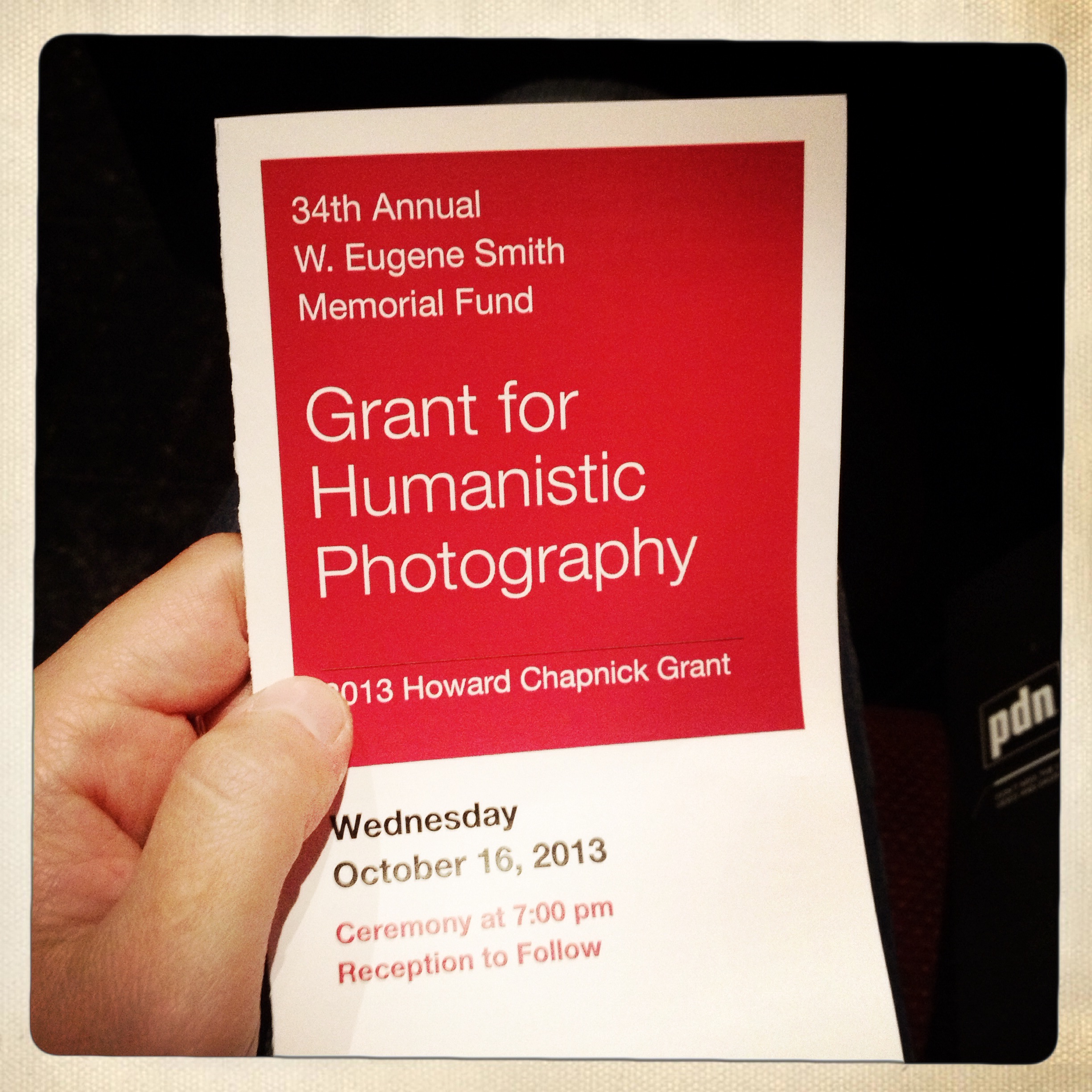Il prestigioso fondo intitolato a Eugene Smith assegna annualmente dei finanziamenti a fotografi che si sono distinti per un progetto o che ne stanno completando uno. Quest'anno, l'assegnazione delle borse premio della sua 34esima edizione si è tenuta il 16 ottobre nel teatro della School of Visual Arts di New York. La serata, incalzante nel ritmo e cadenzata con la precisione che gli americani sanno mettere in questo tipo di eventi, ha alternato interventi a proiezione di lavori fotografici di altissimo livello. Alison Morley, direttrice del corso di Fotografia documentaristica e fotogiornalismo dell’ICP di New York, ha introdotto la prima proiezione: le fotografie di Takeshi Ishikawa.
Vi starete chiedendo (o forse lo sapete già) chi sia Takeshi Ishikawa, come me lo sono chiesto io quando ho letto il suo nome sul programma della serata. Ishikawa, assistente di Eugene Smith dal 1971 al 1974, ha seguito il fotografo durante la realizzazione del suo famoso lavoro Minamata Bay, sulle conseguenze da intossicazione di mercurio. Racconta Ishikawa: “Mentre lavoravo a Minamata, scattavo delle fotografie, ma non avevo alcuna intenzione di renderle pubbliche.
Dopo il 30esimo anniversario della morte di Smith, sono tornato a scattare a Minamata. Mi chiedevo come fosse ora la vita in quel posto e che cosa potessi fare io come fotografo che aveva lavorato per Minamata e per Eugene Smith. Così ho deciso di fotografare gli stessi pazienti che avevano posato per me durante quei giorni di 40 anni prima, a volte nelle stesse località, e di realizzare un “Minamata Notebook” per raccogliere e non perdere la mia esperienza e il ricordo del progetto di Smith.
La prima parte delle foto di Ishikawa mostrano un Eugene Smith al lavoro, in casa con la moglie, addormentato per terra in mezzo alle sue foto. Scatti bellissimi, in un bianco e nero che rende delicato ogni sguardo e ogni luce. La seconda parte è una serie di dittici composti dai ritratti dei malati della malattia di Minamata, 40 anni fa e oggi.
Subito dopo, Brian Storm, presidente e fondatore di Mediastorm, proclama il vincitore dell’Howard Chapnick Grant 2013, vinto dall’organizzazione no-profit FotoKonbit. Maria Arago - presidentessa dell’organizzazione spiega come l’obiettivo di questo progetto sia mostrare Haiti attraverso gli occhi degli Haitiani. FotoKonbit lavora in tutto il paese organizzando workshop fotografici per adulti e bambini e costruendo così un enorme archivio nazionale di immagini. Le proiezioni si sono susseguite rapidamente, ognuna introdotta dall'autore, che presenta il suo lavoro.
I finalisti di quest’anno sono stati Bharat Choudary - “The silence of Others”, sulla difficile integrazione dei musulmani nelle culture non islamiche, Edmund Clark - “Extraordinary Renditions and Hidden Spaces on the Global War on Terror”, Maxim Dondyuk - “TB epidemic in Ukraine”, Sebastian Liste - “The new culture of violence in Latin America”, Benjamin Lowy - “The fetishization of violence in America”, Pierpaolo Mittica - “Fukushima - No Go Zone”, Ebrahim Noroozi - “Victims of Forced Love”, Sim Chi Yin - “Dying to breathe” e Christian Werner - “Deplete Uranium: the silent genocide”.
Javier Arcenillas, madrileno, ha vinto il 2013 E. Smith Fellowship di 5.000 dollari per continuare il suo lavoro “Red Note: violence in Sud America” in cui mostra l’elevatissimo grado di violenza dei paesi Sud Americani. Il fotografo userà questi fondi per andare ad indagare la situazione delle donne vittime di violenza anche nella zona del Centro America. La proclamazione e proiezione del lavoro vincitore del grant 2014 di 30.000 dollari è avvenuta dopo circa un’ora e mezza dall’apertura della serata: Robin Hammond, neozelandese, ha vinto con il suo lavoro “Condemned”, reportage sulle condizioni di vita di pazienti affetti da malattie mentali nei paesi africani. Una serata forte, fatta di immagini con un peso specifico elevato.
Mariateresa dell'Aquila
ENGLISH VERSION
Every year the prestigious Eugene Smith memorial fund awards grants to photographers who stand out for a project they’ve released or are in the process of making. This year’s edition took place at the School of Visual Arts in New York on 16th October. It was an evening with a compelling and perfectly-balanced rhythm - the precision that Americans are great at achieving when it comes to this type of event. It presented a combination of interventions and the projection of a number of extremely high-quality photographic works. Alison Morley, Chair of the Documentary Photography and Photojournalism at ICP New York, introduced the first projection: photographs by Takeshi Ishikawa.
You might be wondering who Takeshi Ishikawa is - just like I wondered when I read his name on the evening’s programme (or perhaps you already know). Ishikawa, who served as Eugene Smith’s assistant between 1971 and 1974, followed the photographer during the making of his famous work Minamata Bay about the implications of mercury poisoning. Ishikawa recalls: “Whilst working at Minamata I would take pictures but I had no intention of publishing them.
I wondered what life was like there at that point and what I could have done as a photographer working for Minamata and Eugene Smith. Hence I decided to shoot the very same patients who’d posed for me 40 years before (sometimes even in the same locations) and to release a “Minamata Notebook” to recollect my experience there and the memory of Smith’s project”. The first part of Ishikawa’s photos depicts Eugene Smith at work - home with his wife, asleep on the floor amongst his photos. They’re beautiful black & white shots that emphasize the delicacy of every look and light. The second part comprises a series of diptychs portraying those sick with Minimata’s disease 40 years ago and now.
On with the evening, Brian Storm, President and founder of Mediastorm, announced the 2013 Howard Chapnick Grant winner - the no-profit organization FotoKonbit. Chair of the organization, Maria Arago, explained the project’s goal -depicting Haiti through the eyes of Haitians. FotoKonbit operates all over the country, setting up photo workshops for adults and children, and building up a large national archive of images.
Photo projections followed one another in rapid succession - each being introduced and presented by their author.
This year’s finalists were: Bharat Choudary - “The silence of Others” (on the difficulties of Muslim integration in non-Muslim cultures), Edmund Clark - Extraordinary Renditions and Hidden Spaces on the Global War on Terror”, Maxim Dondyuk - “TB epidemic in Ukraine”, Sebastian Liste - “The new culture of violence in Latin America”, Benjamin Lowy - “The fetishization of violence in America”, Pierpaolo Mittica - “Fukushima - No Go Zone”, Ebrahim Noroozi - “Victims of Forced Love”, Sim Chi Yin - “Dying to breathe” and Christian Werner - “Deplete Uranium: the silent genocide”.
Madrid-born Javier Arcenillas won the $5,000 2013 E. Smith Fellowship to continue his work “Red Note: violence in South America” on the sky-high level of violence in South American countries. The photographer will be using these funds to portray the situation of Central America women that are victims of violence.
The announcement and display of the $30,000 2014 Grant winner took place an hour and a half into the evening: Kiwi Robin Hammondwon with “Condemned” - a report on the living conditions of the mentally ill in African countries.
It was an undoubtedly powerful evening of high-standard images.
Mariateresa dell'Aquila
The articles here have been translated for free by a native Italian speaker who loves photography and languages. If you come across an unusual expression, or a small error, we ask you to read the passion behind our words and forgive our occasional mistakes. We prefer to risk less than perfect English than limit our blog to Italian readers only.


Leave a Reply